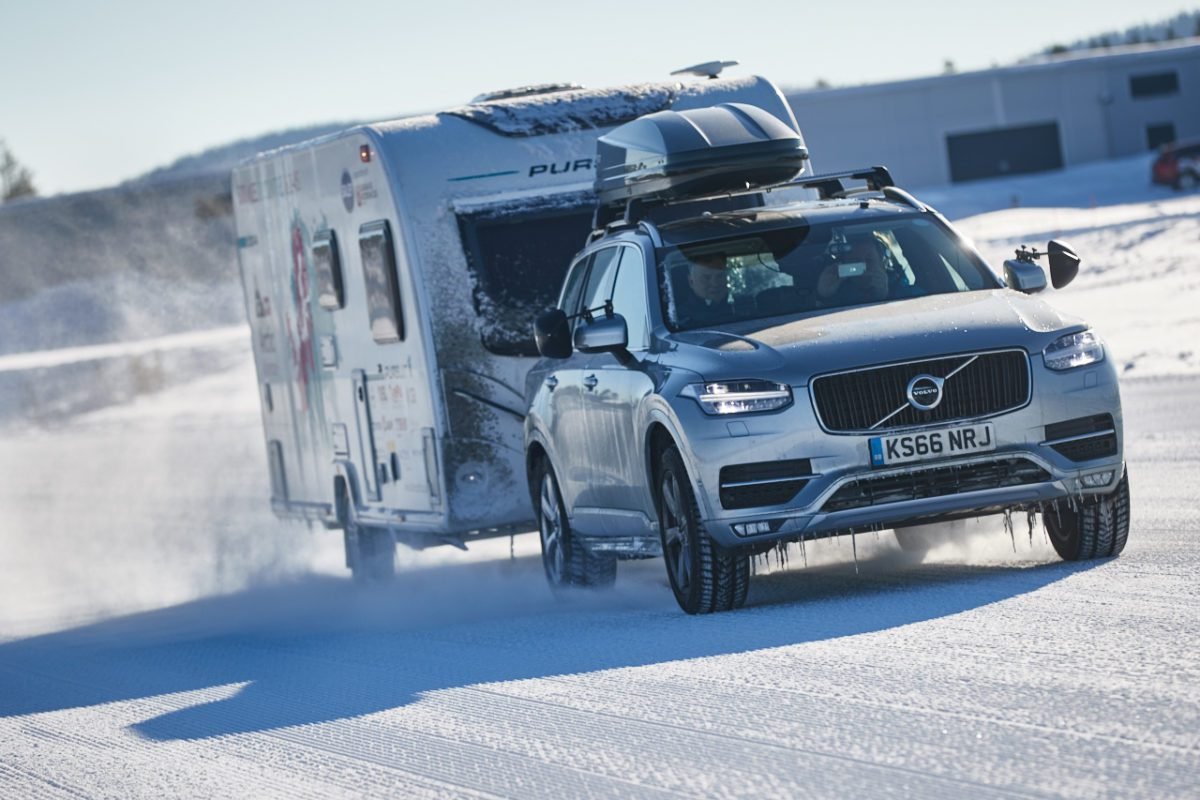For many people, caravanning is a fair weather activity that they’ll embark on during the warmer and less rain-drenched months of the year. And who can blame them? The UK can be a pretty bleak place during the wind-battered winter when only the most avid caravanners are pitching up on site.
However, with the right preparation and planning, caravaning in winter can be a truly joyous endeavour. With the right equipment and knowhow you can brave the elements and see some of this nation’s most spectacular scenery when it’s at its most harsh and brutal. Everyone can wander a pretty beach in summer, but who is out in the thick of it when the waves are crashing up over the beach? Well that could be you!
That’s why we’ve put together this guide to using a caravan in winter. We wanted to equip you with all the knowledge you need to get out and make the most of your caravan all through the year.
Is it OK to Use a Caravan in Winter?
First and foremost, the answer to this question is yes! As long as you are nicely prepared and your caravan isn’t full of leaks and holes, then you’re most definitely able to go out and use your caravan in the colder months of the year.
The one thing you do need to bear in mind is the grade of your caravan. Most modern caravans are listed as grade 3. This means they can be comfortable at up to -15°C. However, older caravans are usually grade 2, meaning they are only rated for temperatures as low as freezing.
But, as long as your caravan is safe to use in the cold temperatures, and you’re not heading off anywhere too perilous, then yes, you can use your caravan in winter!
How to Keep a Caravan Warm in Winter
The first questions most people have when considering caravanning in winter is, how do I fight those falling temperatures and keep a caravan warm in winter? So, here are some tips on how to ensure that your caravan stays nice and warm in winter.
Add insulation where you can
Your caravan may already be nicely insulated for use in cold weather. However, you may be able to add additional insulation here and there to help make it hold onto the heat better.
Firstly, you can fix plastic sheeting to windows for an additional layer of protection against the cold. Or, if you want to invest further, why not opt for installing curtains or thermal blinds? These can help deflect cold from outside and provide you with another layer to preserve the warmth that’s already in your caravan.
Another option is to add foam matting on the floors to help protect against cold feet. However, if you really want to tackle cold feet, then you can follow our next piece of advice.
Consider adding dry underfloor heating
If you’re a lover of toasty toes during the colder months, then be sure to invest in dry underfloor heating.
Touring caravans are nicely suited to dry underfloor heating systems as opposed to wet systems. This is because dry systems tend to take up much less space and run off of an electric source.
When installing this, professionals will place very thin electric cables or mats beneath your caravan’s floor. These will then provide you with a gentle form of heat that rises upwards keeping you and your loved ones warm.
Always speak to a professional before installing this heating as they will be able to tell you if your caravan’s structure is solid enough to withstand the installation.
You can purchase an electric heater
Electric heaters provide you with another quick win. You can pull up to your pitch in gale force winds, with the temperature lingering around zero, but once you plug in your electric heater and get it going, it won’t take long for the warmth to spread.
Electric heaters are a nice and easy option, but it is worth noting that they will require a socket and an electricity source to get them going. But once they are plugged in, they tend to be fairly efficient and get to work quickly.
Install a wood-burning fireplace
This is a much bigger and bolder move than simply plugging in an electric heater. But if you’re serious about using your caravan in the colder months and you don’t mind the added expense of installation, then adding a wood-burning stove to your caravan can be a great idea.
It’s not a simple or easy thing to do, though. So make sure you use a professional to install the burner. And it’s also a good idea to understand that for safety purposes you may have to change some of the materials that sit close to your new stove.
You’ll also have to make sure that you bring appropriate amounts of dry wood for fuel, so you can continue to heat your caravan throughout your trip. But, wood-burning fireplaces tend to kick out a lot of heat, so it won’t take long for your caravan to be toasty and warm.
Install an awning
Did you know your awning can also help insulate your caravan? A porch awning positioned over the entrance can reduce heat loss when you open the door. However, make sure you never block air vents, even if they create a draught. Obstructing them poses a serious fire risk.
Install double-glazed windows
Most caravans will make use of double-glazed windows these days for energy efficiency. But if your caravan still has single-glazed windows, then a switch to double can work wonders for your heat loss. Though it’s also worth bearing in mind that this will make your caravan warmer in the hotter months too. So be prepared for this.
If you don’t fancy switching to double-glazing, then you can always add a layer or two of plastic sheeting to the inside of your single-glazed windows for added cold protection.
Tips for Caravaning in Winter
So once you’ve prepped your caravan and it’s all ready for the cold, you may wish to hit the road! However, before you do so, here are a few more things that we feel you should consider when caravanning in winter.
Insulate your external water tanks and pipes
Winter camping can pose a risk to your caravan’s external water carriers, which are particularly vulnerable to freezing. To avoid this, consider investing in an insulation bag, or if you’re in a pinch, use materials like bubble wrap, an old duvet, or even a spare coat to insulate the tank.
For added protection, keep a small container of fresh water inside the caravan, providing an emergency supply if the external container freezes.
Wastewater pipes can freeze too, so it’s wise to insulate them and add salt to the wastewater container or use a glycol-free antifreeze to keep things flowing smoothly.
Switch to propane gas
Many caravan owners use butane for heating and cooking, as it’s cheaper and more widely available. However, butane struggles to perform in low temperatures, making propane a far more reliable choice during the winter. Before switching, double-check that your appliances are compatible with propane, and ensure you have a full bottle before setting off. It’s also worth researching where to exchange bottles along your route, just in case you need to refuel.
Bring your step inside at night
To avoid a hazardous, ice-covered step in the morning, it’s a good idea to bring your caravan step inside overnight. If you prefer to leave it outdoors, consider covering it with antifreeze or sprinkling rock salt to prevent it from becoming dangerously slippery.
Pack a spare leisure battery
Cold weather can cause you to become over reliant on your electrical appliances. This can quickly drain your caravan’s leisure battery. That’s why it is wise to bring a spare, fully charged leisure battery with you when you’re using your caravan in winter.
Always ensure proper ventilation
While it may be tempting to block or close vents to conserve heat, doing so can lead to dangerous consequences, especially in a confined space like a caravan. Proper ventilation is key to preventing condensation and reducing dampness. One handy tip is to always position your caravan so that vents are shielded from prevailing winds, allowing for airflow without you falling victim to some serious drafts.
Pack warm bedding and clothing
It might seem obvious, but bringing the right clothing and bedding is vital for winter caravanning. Pack plenty of jumpers, waterproofs, hats, scarves, and thick socks. It’s also a good idea to upgrade your duvet’s tog rating and don’t forget to bring a hot water bottle for extra warmth at night.
Tips on Driving with your Caravan in Winter
Another thing to consider, if you’re thinking about taking your caravan out in the winter, is how to drive when towing a caravan in tricky weather conditions. Here are some tips that might help you deal with cold, windy, and icy weather when towing your caravan.
Equip your vehicle with winter tyres
Towing a caravan can be a challenge in any weather, but icy, snow-covered roads add an extra layer of difficulty. Fitting winter tyres to both your tow vehicle and caravan is essential for improving your grip on slippery roads. With better traction, you’ll find steering more responsive and stopping distances shorter compared to standard tyres, which can come in handy in an emergency.
Pack tyre grip mats
Winter tyres will improve your chances of avoiding trouble in snow, ice, or mud, but they’re not foolproof. Packing tyre grip mats is a smart precaution, should you find yourself stuck in the mud. If you do get wedged somewhere, then you can simply slide these mats under your tyres to gain traction, helping you ease out of a tricky spot without needing to channel your inner rally driver.
Drive with caution and plan ahead
Towing a caravan or handling a large motorhome on icy roads requires extra care. So when driving make sure you reduce your speed and make smooth, measured steering adjustments to keep your vehicle stable.
Evenly distributing weight throughout your caravan will also reduce the risk of losing control. It’s also worth remembering not to rush. Leaving extra time for your journey ensures you won’t feel pressured to drive faster than the conditions allow, meaning you are much more safe on the road.
Fit a towing jacket
Protect your caravan from the muck and grime of winter roads by fitting a towing jacket. This cover will shield the front of your caravan from the spray of dirty rainwater and help guard against minor damage from road debris.
Protecting Your Caravan in Winter When Not in Use
If you’ve decided not to take your caravan out this winter, then you will want to make sure you’re doing all you can to protect it. If it’s sitting on your drive or locked away in storage, then you need to remember that the cold weather can still get to it. Get our winter storage tips in our caravan and motorhome winterisation guide.
Happy Winter Caravanning
So, we’ve outlined that with the right preparation, winter caravanning can be a truly enjoyable experience.
Make sure you stay warm, by adding insulation, such as thermal blinds or foam mats, and consider dry underfloor heating or electric heaters. Wood-burning stoves are another option, but require professional installation. An awning helps reduce heat loss, while double-glazed windows improve insulation.
When camping, insulate water tanks and pipes, switch to propane for better performance in the cold, and pack extra warm clothing and bedding! And if your caravan’s not in use, make sure you protect it by checking for cracks, preventing mould, and draining water systems to avoid freezing damage!




 Spidersnet
Spidersnet